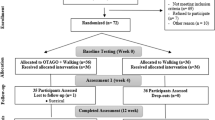Abstract
Background and aims: Feasible and low-cost exercise programmes targeting fall risk factors may decrease the risk of falling in older adults. The purpose of this study was to compare the effects of square-stepping exercise (SSE) training, which is a new and low-cost method designed to improve lower-extremity functional fitness, with strength and balance (SB) training. Methods: The study included 39 community-dwelling adults aged 65 to 74 years. The participants were randomized to either group SSE (n=20) or SB (n=19). They engaged in 70-min group exercise sessions twice a week for 12 weeks. The efficacy of the program was measured with both a 9-item test battery for assessment of physical performance and self-reported scales (fear of falling, pleasure in exercise, perceived health status). Fall incidence was followed up for 14 months. Results: The results of a 2-way ANOVA revealed that the time effect in 7 of the 9 performance tests was significant, although group-by-time interactions were not. No significant changes were observed in the self-reported scales. During the 14-month follow-up period, 7 falls in 6 participants in the SSE group and 12 falls in 11 participants in the SB group were reported. The incidence rate per person in the SSE group (30.0%) was not significantly different from that in the SB group (57.9%). The rate of falls per trip [falls/(falls + trips)] in the SSE group (17.1 %) was significantly lower than in the SB group (50.0%). Conclusions: SSE is as equally effective as SB training in improving lower-extremity functional fitness. SSE may also be recommended for older adults, due to its low cost and effectiveness.
Similar content being viewed by others
References
Committee for Osteoporosis Treatment of the Japanese Orthopaedic Association. Nationwide survey of hip fractures in Japan. J Orthop Sci 2004; 9: 1–5.
Pavol MJ, Owings TM, Foley KT, Grabiner MD. Mechanisms leading to a fall from an induced trip in healthy older adults. J Gerontol A Biol Sci Med Sci 2001; 56A: M428–37.
Maki BE, McIlroy WE. Control of rapid limb movements for balance recovery: age-related changes and implications for fall prevention. Age Ageing 2006; 35 (Suppl. 2): ii12–8.
Blake AJ, Morgan K, Bendall MJ, et al. Falls by elderly people at home: prevalence and associated factors. Age Ageing 1988; 17: 365–72.
Carter ND, Khan KM, Petit MA, et al. Results of a 10-week community based strength and balance training programme to reduce fall risk factors: a randomised controlled trial in 65–75 year old women with osteoporosis. Br J Sports Med 2001; 35: 348–51.
Hauer K, Rost B, Rutschle K, et al. Exercise training for rehabilitation and secondary prevention of falls in geriatric patients with a history of injurious falls. J Am Geriatr Soc 2001; 49: 10–20.
Wolf SL, O’Grady M, Easley KA, Guo Y, Kressig RW, Kutner M. The influence of intense Tai Chi training on physical performance and hemodynamic outcomes in transitionally frail, older adults. J Gerontol A Biol Sci Med Sci 2006; 61: 184–9.
American Geriatric Society, British Geriatric Society, and American Academy of Orthopaedic Surgeons Panel on Falls Prevention. Guideline for the prevention of falls in older adults. J Am Geriatr Soc 2001; 49: 664–72.
Li F, Harmer P, Fisher KJ, et al. Tai Chi and fall reductions in older adults: a randomized controlled trial. J Gerontol A Biol Sci Med Sci 2005; 60: 187–94.
Shigematsu R, Okura T. A novel exercise for improving lower-extremity functional fitness in the elderly. Aging Clin Exp Res 2006; 18: 242–8.
Bassey EJ, Short AH. A new method for measuring power output in a single leg extension: feasibility, reliability and validity. Eur J Appl Physiol Occup Physiol 1990; 60: 385–90.
Rikli RE, Jones CJ. Development and validation of a functional fitness test for community-residing older adults. J Aging Phys Act 1999; 7: 129–61.
Shigematsu R, Tanaka K. Age scale for assessing functional fitness in older Japanese ambulatory women. Aging Clin Exp Res 2000; 12: 256–63.
Feder G, Cryer C, Donovan S, Carter Y. Guidelines for the prevention of falls in people over 65. BMJ 2000; 321: 1007–11.
Lamb SE, Jorstad-Stein EC, Hauer K, et al. Development of a common outcome data set for fall injury prevention trials: The Prevention of Falls Network Europe Consensus. J Am Geriatr Soc 2005; 53: 1618–22.
Madigan ML, Lloyd EM. Age and stepping limb performance differences during a single-step recovery from a forward fall. J Gerontol A Biol Sci Med Sci 2005; 60A: M481–5.
Thelen DG, Muriuki M, James J, Schultz AB, Ashton-Miller JA, Alexander NB. Muscle activities used by young and old adults when stepping to regain balance during a forward fall. J Electromyogr Kinesiol 2000; 10: 93–101.
Author information
Authors and Affiliations
Corresponding author
Rights and permissions
About this article
Cite this article
Shigematsu, R., Okura, T., Sakai, T. et al. Square-stepping exercise versus strength and balance training for fall risk factors. Aging Clin Exp Res 20, 19–24 (2008). https://doi.org/10.1007/BF03324743
Received:
Accepted:
Published:
Issue Date:
DOI: https://doi.org/10.1007/BF03324743




